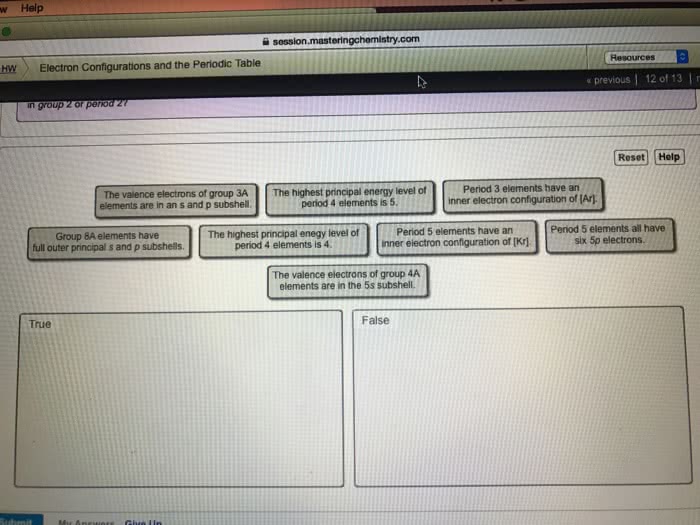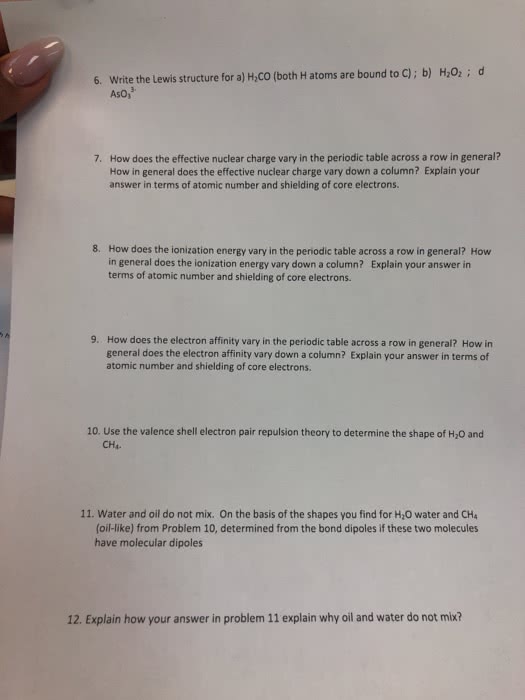CHEM 110 Chapter Notes - Chapter 8: Alkali Metal, Ion, Covalent Bond

Chapter 8
Nerve Signal transmission
- Sodium Ions are pumped out of the cells, while potassium are pumped into the cell
o Result is a chemical gradient for each ion
o Sodium is higher outside the cell than within
o The size of sodium and potassium is an example of a periodic property
▪ Predictable based on an elements position within the table
▪ Examine properties such as atomic radius, ionization energy and electron
affinity
Electron Configurations, Valence Electrons and Periodic Table
- The number of electrons in the outermosts principal energy level remains the same
- An atoms valence electrons are the electrons important in chemical bonding
o The valence electrons are those in the outermost principal energy level
▪ The chemical properties depend on its valence electrons
▪ Elements in a column of the periodic table have similar properties
• Same number of valence electrons
o Valence electrons are distinguished from all the other electrons in an atom
▪ Core electrons
▪ In Complete principal energy levels and those in complete d and f
sublevels
• Silicon with configuration 1s22s22p63s23p2 has 4 valence electrons
▪ Example: Write the electron configuration for Ge by determining the total
number of germanium’s atomic number (32)
• Ge 1s22s22p63s64s23d104p2
o Valence are 4s24p2
• Its valence electrons are those in the outermost principal energy
level
o N = 1, 2 and 3
o N = 4 is the outermost
▪ N = 4 electrons are valence and the rest are core
- Orbital Blocks in the Periodic table
o Because of the filling order of orbitals, periodic table can be divided into blocks
representing the filling of particular sublevels
▪ First two columns comrpsie of the s block, with outer configurations of ns1
(Alkali metals) and ns2 (Alkaline earth metals)
▪ Six columns on the right side of the periodic table comprises of p block
• With outer Electrons configurations of ns2, np1, ns2np2, ns2np3,
n2p4, n2np5 and n2np6
▪ Transition elements comprise the d block
▪ Lanthanoids and actinoids comprise the f blocks
o You can see the number of columns in a block corresponds to the maximum
number of electrson that can occupy the particular sublevel of that block
▪ S blocj has 2 columns
▪ P block has 6 columns
find more resources at oneclass.com
find more resources at oneclass.com

▪ D block has 10 columns
▪ F block has 15 columns
o The periodic table is divisible into four blocks corresponding to the filling of the
four quantum sublevels (s, p, d, f)
o The row number of a group element is equal to the highest principal quantum
number of that element
- Writing an electron configuration for an element for its position in the periodic table
o The organization of the periodic table allows us to write the electron configuration
for any element based on the position in the table
▪ Example: Suppose we want to write the electron configuration for Cl
• Inner electron configuration is that of a noble gas
• Outer electron configuration is obtained by tracing elements
between Ne and Cl
▪ Begin with Ne
▪ Add in the two 3s electrons.
▪ Followed by five 3p electrons
• Cl (Ne) 3s23p5
- D-block and F-block elements
o The pricnicpal quantum number of the d orbital being filled across each row in the
transition series is equal to the row number minus one
▪ In the fourth row, the 3d oribitals fill; in the fifth row, the 4d orbitals fill
▪ As we move across the f block, the f orbitals fill
• The principal quantum number of the f orbital being filled across
each row is the row number minus two
o In the sixth row, the 4f orbitals fill, and in the seventh row,
the 5f orbitals fill)
• Example: Use periodic table to write an electron configuration for
Selenium (Se)
o Se atomic number is 34
o Noble gas that precedes Se is Argon
▪ Inner configuration is (Ar)
▪ Trace the elements between Ar and Se and
assigning electrons to appropriate orbitals
• Begin with Ar
• Add two 4s electrons (n = row number)
• Add ten 3d electrons (N = row number -1)
• Add four 4p electrons (N = row number)
Explanatory Power of the Quantum-Mechanical Model
- The chemical properties of elements are largely determined by the number of valence
electrons they contain
o When a quantum level is completely full, the overall energy of the electrosn that
occupy that level is particularly low.
o Electrons cannot lower their energy by reacting with other atoms
find more resources at oneclass.com
find more resources at oneclass.com

o Noble gases are the most chemically stable and relatively unreactive family
o Elements with electron configurations close to those of the noble gases are the
most reactive because they can attain noble gas electron configurations by losing
or gaining small number of electrons
▪ Alkali are among most reactive because their outer electron configuration
(ns1) is one electron behind noble gas configuration
Periodic trends in the size of atoms and Effective Nuclear Charge
- One way to define the atomic radii is to consider the distance between nonbonding atoms
that are in direct contact
o Krypton can be frozen into a solid in which the krypton atoms are touching each
other but are not bonded
o Distance between the centres of adjacent krypton atoms
▪ Determined from solid’s density
▪ Twice the radius of a krypton atom
▪ Nonbounding atomic radius (Van der waals radius)
- Another way to define the size of an atom (Covalent Radius) is
o Nonmetals: One-half the distance between two of the atoms bonded together
o Metals: One half the distance between two of the atoms next to each other in a
crystal metal
▪ Distance between Br atoms in Br2 is 228pm
• Br covalent is 114pm
o Atomic radius refers to a set of average bonding raii determined from
measurements on a large number of elements and compounds
▪ Represents the radius of an atom when it is bonded to another atom and is
awlays small than the van der Waals radius
▪ Bond length of any two covalently bonded atoms is the sum of hteir
atomic radii
• Bond length for ICl is iodine’s atomic radius plus chlorine atomic
radius
o 232pm
▪ As we move down a column, atomic radius increases
▪ As we move to the right across a period, atomic radius decreases
o Largely determined by the valence electrons, the electrosn farthest from nucleus
o Atomic radii, increase as we move down, and decrease as we move to the right
across the table
- Nuclear Charge
o According to Coulombs law, the attraction between a nucleus and an electron
increases with increasing magnitude of nuclear charge
▪ Compare Hydrogen and Helium
• H 1s1
• He+ 1s1
▪ It takes 1312 kJ mol-1 to remove 1s from 1mol of hydrogen
▪ 5251 kJ mol-1 to remove electron from equivalent orbital in 1 mol of He+
• Why? The helium ion is attracted to the nucleus with a 2+ charge,
while electron in hydrogen is attracted to nucleus by 1+ charge
find more resources at oneclass.com
find more resources at oneclass.com



